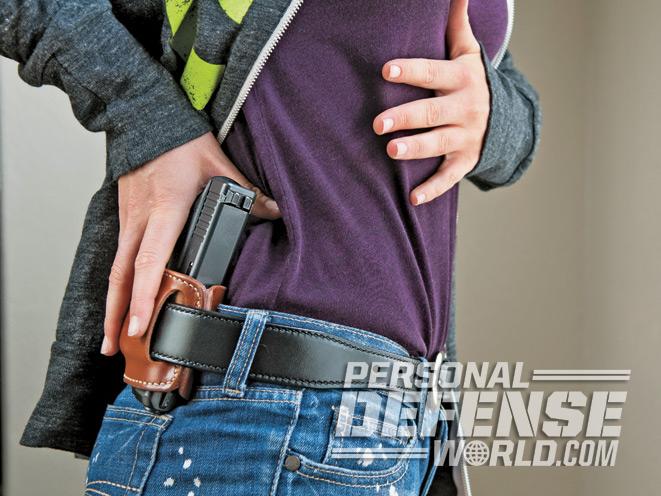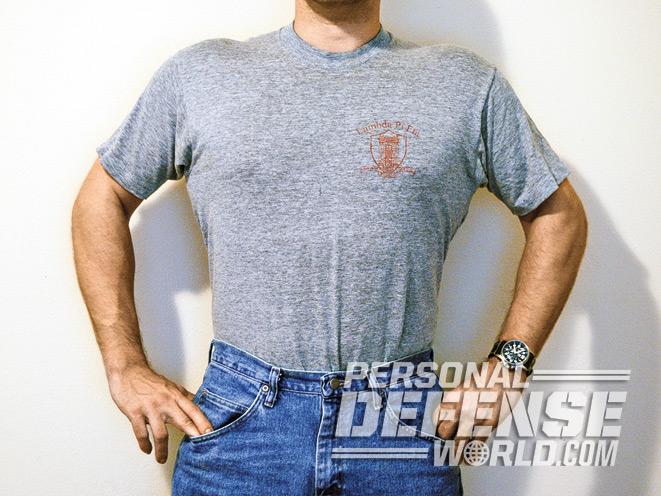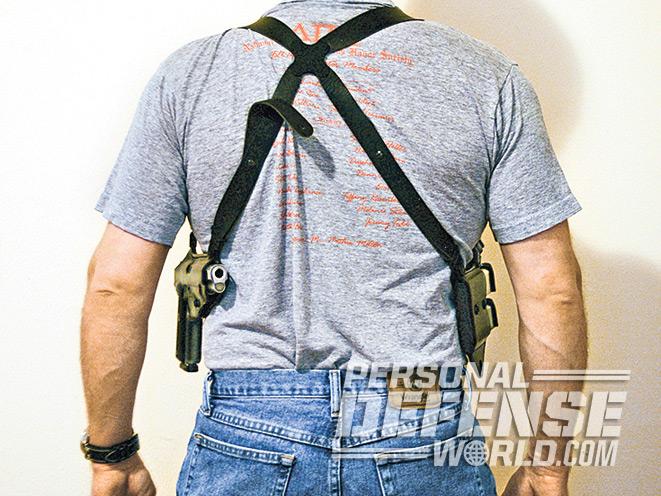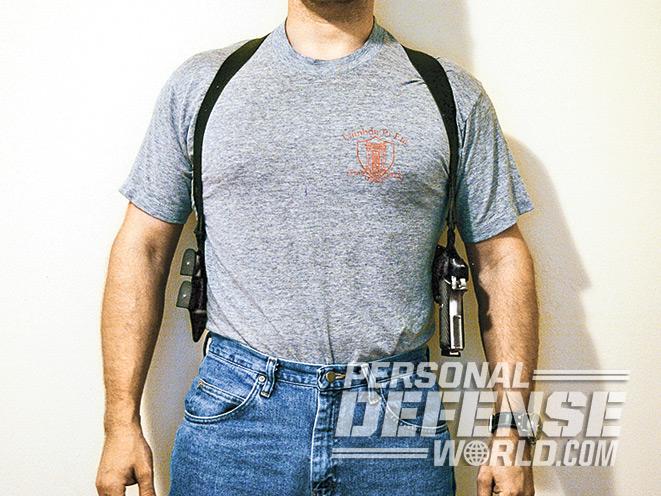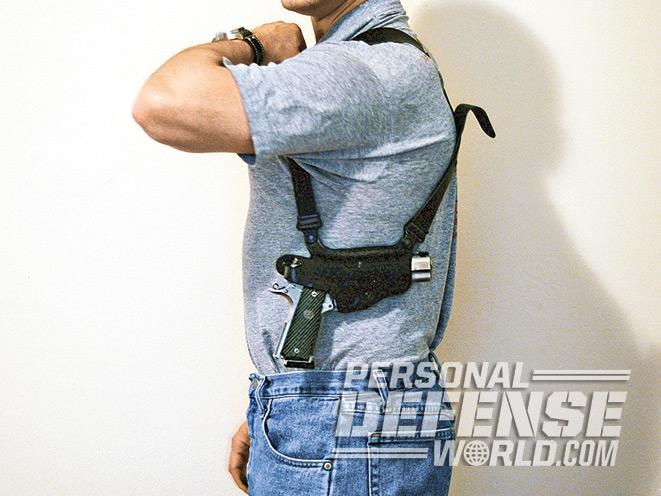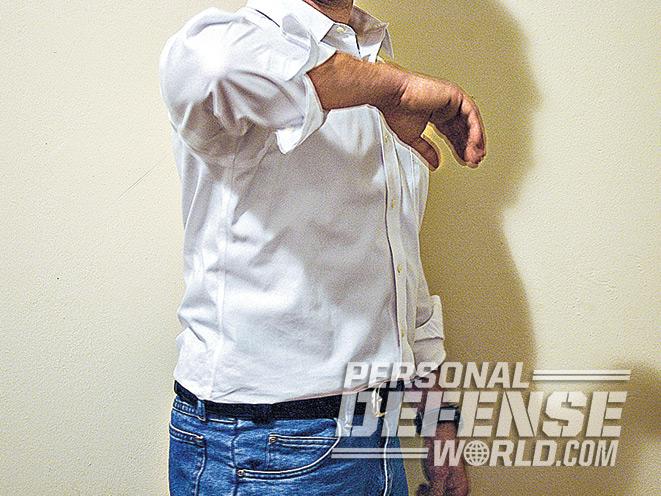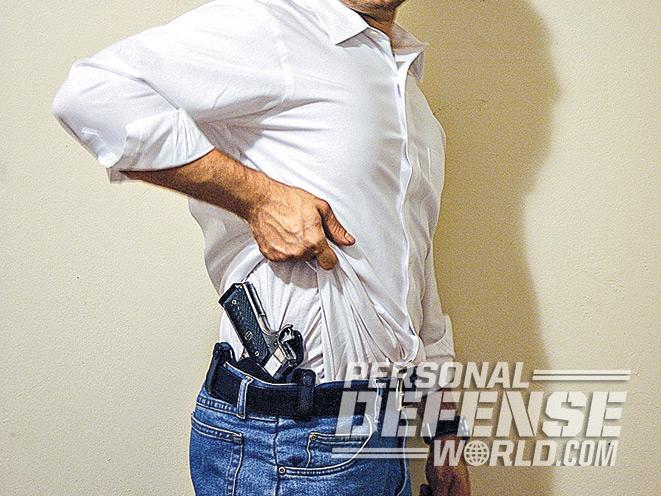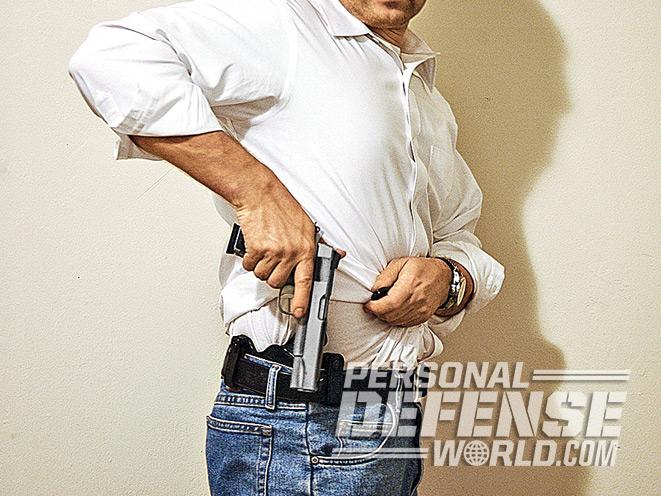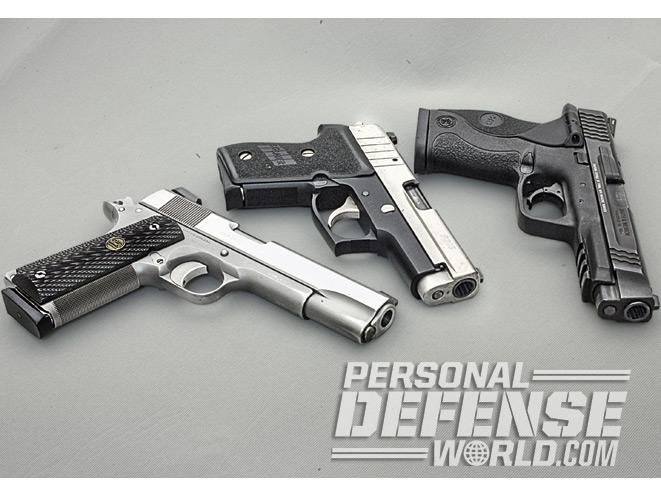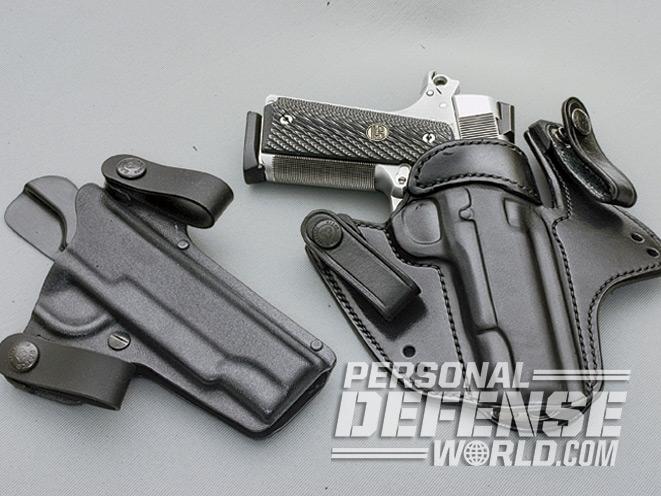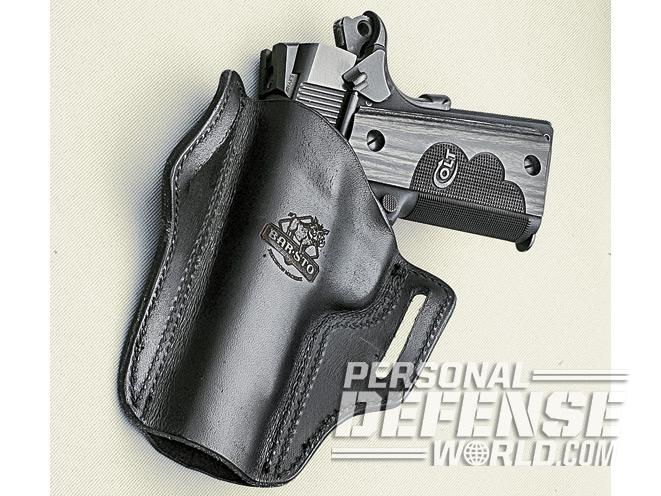For several years, I’ve had an ongoing disagreement with two of my shooting friends who carry small-caliber guns for self-defense. Although they both own full-size pistols in .45 ACP and other calibers (and know that I carry a full-sized .45 ACP every day), they tell me that they cannot carry larger guns because it’s not “practical.” This had largely been an idle intellectual exercise until one day when one of those friends nearly found himself—along with his wife and child—in a confrontation with three thugs in a parking lot. He was carrying a .25 ACP.
Not only is the .25 ACP not to be relied on as a stopper, tthe odds of shooting a pistol accurately when it has virtually no sights and a sight radius shorter than the blade of your pocket knife aren’t exactly good—something that he technically knew beforehand, but became acutely aware of there under the streetlights. Like many people who carry a concealed pistol, he had picked something he could hide easily, without much regard for whether it was powerful enough to stop a fight, or whether its size made it too difficult to shoot effectively while under stress.
Personally, I seldom carry anything but a .45, generally some variant of the M1911. Not only does it combine accuracy and power, but it also is flatter than many modern semi-auto pistols, making it easier to conceal. Weapon choice, though, is a very small part of the equation. Here, we’ll focus on concealment and leave the operational aspects of the different styles of holsters for another day. Hiding the gun usually depends on three variables: clothing, body type and holster selection.
Advertisement — Continue Reading Below
Dress Around Your Firepower

Perhaps the most obvious of the three is clothing selection. The simple fact is, if you intend to effectively conceal a large-frame pistol, you’re going to have to wear loose-fitting clothing—gone are the skintight T-shirts, if you’re in to that sort of thing. While not mandatory, wearing untucked shirts and jackets represent a compromise. But since most of us live in a world that prescribes something between semi-formal and ultra-casual dress, neither of those options is going to be entirely appropriate, leaving you either a little underdressed (untucked shirt) or overdressed (sports coat). The good news is that, with today’s more relaxed dress codes, dressing a little outside the norm is less conspicuous as it once was. When in doubt, I’ll usually overdress, unless I’m going to be in an environment where it would make me more of a target.
Different Body, Different Carry
Advertisement — Continue Reading Below

Effective concealment also boils down to where the gun can lay the most flat against your body. If it leans outboard, or juts out past whatever part of the body it’s carried against, you lose—the gun is visible. What you want is someplace where the gun’s length and height don’t protrude and where its width from your body is least noticeable. Despite the obvious dangers of carrying a gun stuffed down the front of the pants, that’s why it’s perennially popular: The stomach area is one of the largest, most accessible, flat areas of the body, and the profile of the gun is readily blanked out by your form. Since the chest area is generally larger than the stomach, the natural drape of a shirt tends to break up the gun’s width.
RELATED: 23 New Full-Size Handguns For 2015
You will note, however, that my description of the human body depends somewhat on physique. To a great extent, build determines where you can most effectively conceal a pistol. In my case, I stand about 5 feet 10 inches, have a fairly athletic build and usually wear a 32-inch waist and 42-inch jacket. While it’s devilishly hard to find suits that fit, the difference in size between my shoulder/chest area and waist makes it very easy to conceal a pistol on my belt. Jackets and shirts tend to drape straight down, leaving a space between the garment and my body that’s very easy to slip a pistol into. On the other hand, because my lats are larger than average, it’s more difficult for me to hide a horizontal shoulder holster, since the clump of muscle beneath my arm tends to push the gun outboard if I wear it too high. While it’s easy to “lose” the width of the gun, unless I carry something with a very short barrel, the length of the gun protrudes toward the rear. Vertical shoulder holsters can work better for me, but unless I wear a garment with some structure to it, say, a leather jacket, it tends to leave a telltale vertical ridge when seen from the rear.
Advertisement — Continue Reading Below
If you carry weight around your midsection, belt carry can also be a problem, since the gun digs into your side. Not only is it uncomfortable, it pushes the butt of the gun outward, again making it obvious. While I’m generally not a fan of small-of-back carry, since it’s not particularly accessible, for some people that may be the only way to carry a gun on the belt. It’s usually the part of the waist with the least extra padding.
The Right Holster
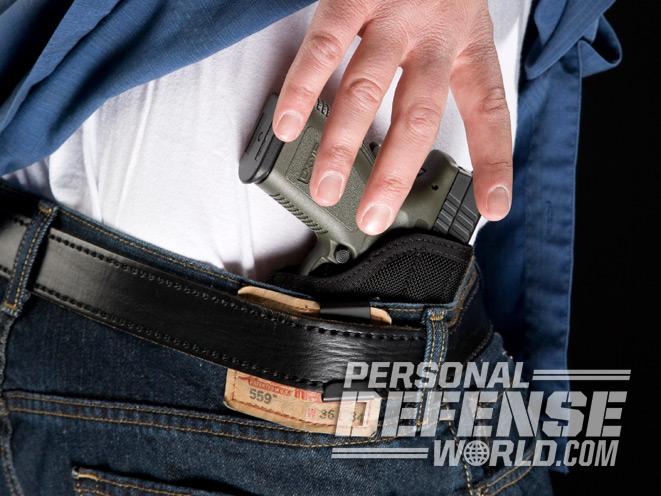
Advertisement — Continue Reading Below
A holster helps to not only conceal the gun, but also to keep it in place and stabilized so it’s in the same place every time you reach for it. All three are important for concealment leather.
For belt holsters, there’s either the inside-the-waistband (IWB) holster with your shirt tucked in around it, or a belt holster with a jacket or shirt that’s entirely untucked. The choice between these two holsters is one of speed: While it may take two hands to get to a pistol beneath a tucked-in shirt (with your support-side hand pulling up the shirt and your strong-side hand going for the gun), it’s usually faster to sweep a coat back to draw a gun from a belt holster, which you can do one-handed. Of course, you can wear an IWB under a jacket too, and the same will apply. The main advantage to the IWB/jacket combination is that, since no part of the holster is visible below the belt, the holster is less likely to be seen if and when the jacket rides up, a common error for those wearing belt holsters.
There’s also a lot to be said for matching the color of your holster and the clothing that you wear. As an extreme example, you can wear a black pistol such as a Glock or S&W M&P in a black holster, with black pants and a black shirt. If your jacket flaps open momentarily, the odds are good that your gun won’t be noticed. On the other hand, a brown holster against jeans and a white shirt is much more likely to catch someone’s eye. Incidentally, this is one reason why nickel and ivory (or pearl) has historically been a popular finish–grip combination. When worn against a white shirt, the light-colored gun and grips draw less attention than you’d think.
Advertisement — Continue Reading Below

While I usually carry a 5-inch Government Model, one of my favorite after-hours pistol is a Detonics Combat Master .45 with elk grips in a Ken Null IWB holster. Worn with jeans and a black sweater during the winter, or even under a tucked-in, white dress shirt during spring and summer, it simply disappears. Since it’s an M1911, it’s flat—the über-short butt and 3.5-inch barrel don’t take up much room on the belt, and the stocks don’t show through a light-colored shirt. Galco’s V-Hawk holster is also an excellent choice. Unlike most IWBs, it uses offset belt loops, which are forward and aft of the body of the holster, so they add no width to the gun itself. Very clever and very functional. I carried a Government Model in it under a white dress shirt for a week or so without anyone noticing.
RELATED: 27 New Handgun Holsters For 2015
A variant of the offset-loops rig is the DeSantis Intruder, which uses a leather backing plate, to which the belt loops and a Kydex holster are attached, offering the comfort and malleability of leather where it rides against your body and the retention and thinness of Kydex where it holds the gun. I used a similar belt holster to carry a Ruger SR9c during a Gunsite class recently and came to admire the concept.
Advertisement — Continue Reading Below
And don’t think that effective IWB carry is limited to single-stack pistols. While working on this article, I spent some time carrying an S&W M&P .45 in DeSantis’ Cozy Partner IWB. A traditional leather IWB with a slight rake that cants the butt of the gun forward, it concealed easily under a jacket, and, while IWB carry is not known for its comfort, it wasn’t at all uncomfortable. One downside to carrying such a large pistol inside the waistband, though, is that you’ll need to purchase pants that fit both you and the gun. (I usually have my suits tailored around a gun.) You’ll also have to use a belt that’s more flexible than what is typically ideal for carrying, since a stiff belt will relentlessly drive the gun into your side.

Belt holsters that carry the gun vertically—with the barrel pointed straight up and down—don’t work particularly well for me. These are generally intended to be worn around the center seam on the pants leg, which is the narrowest part of the waist, and thus offers the least amount of your body to conceal the height and length of the gun. On me, since the butt points almost straight back, it holds my jacket out like a jib boom behind me, making the gun pretty hard to miss.
RELATED: 26 New 1911-Style Pistols For 2015
Advertisement — Continue Reading Below
The “FBI rake,” however, which usually holds the gun in something close to a 15-degree angle, works better since it tilts the butt forward. Rotate the holster around your belt to the rear, behind the seam line, and the butt lies flat against your ribcage. While we think of the “FBI rake” as being a belt holster feature, many IWB’s also come with a butt-forward rake.
If you carefully assess your specific needs and choose to carry a small-caliber pistol, it’s hard to question the decision. But don’t make it based on the assumption that it’s impossible to carry anything bigger. Tell me you won’t, but don’t tell me you can’t.
Advertisement — Continue Reading Below
For More Information
DeSantis Holster & Leather Goods Co.
http://www.desantisholster.com; 800-424-1236
Galco International, Inc.
http://www.galcogunleather.com; 800-874-2526
K.L. Null Holsters, Ltd.
http://www.klnullholsters.com; 706-625-5643
